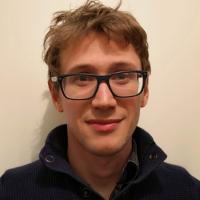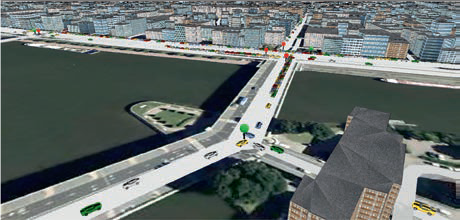
Climate change and risks Reading time 5 min
Patrick Taillandier, a model modeler
Published on 05 March 2019
What do the following have in common: the spread of vegetarianism within a population, building evacuation procedures in the case of fire, and the predicted impacts of self-driving cars on traffic patterns ? They are all situations that need to be analysed by taking into account decision-making and complex behaviours given unpredictable circumstances or disruptive events. Examples include natural catastrophes, the introduction of new technologies, or the emergence of new social behaviours. These analyses are the specialty of Patrick Taillandier, who is helping to develop a handy tool: the GAMA platform. After obtaining an undergraduate engineering degree in informatics from a "Grande École” in Lyon, Patrick quickly went on to earn a master's in artificial intelligence.
Creating a modeling tool for non-specialists
The development of the GAMA platform has been an essential part of his work ever since he finished his PhD. The platform makes it possible for all users, even those who are not informaticians, to build their own models. GAMA first came to life in Vietnam, in the French National Research Institute for Sustainable Development (IRD) laboratory where Patrick was doing a postdoc. However, it is now an international effort, with contributions from research teams in France, Vietnam, and the Netherlands. With a touch of pride, Patrick notes, "It is being used in more and more countries: the USA, China, Austria, the Philippines, and Senegal." A US company recently employed GAMA to predict the consequences of introducing self-driving cars in the city of Boston. The platform is open source, and its 1,000 to 2,000 users are scattered across the world. They are mostly researchers who work with governmental technical services departments or policymakers.

The perfect risk management tool
Solving concrete risk management issues
GAMA's methodological approach offers a way to solve practical risk management issues, such as designing an optimal evacuation signalling system in the case of a tsunami or modelling environmental factors that could influence the probability of H5N1 avian influenza outbreaks. This approach is centred on agent-based simulations, which means that complex systems are broken down into agents that are classified based on their behaviour. These agents are used to model system interactions and changes over time. For example, in a model of road traffic, each driver and each car is an agent, whose behaviour will be analysed and then projected into different scenarios, which will depend on the user's configuration of the road network. "It is a very powerful tool that can be applied in many fields,” comments Patrick with enthusiasm.
This video reconstructs the events of a nightclub fire in Rhode Island, which took place on February 20, 2003. It shows how one-third of the survivors got out through the main door, while another third escaped via the windows. Result: 100 people killed and 230 people injured.
Interdisciplinary projects addressing important societal issues
Patrick has helped apply the platform in a variety of situations, including some involving risk management, mobility and transport, and ecological and environmental issues. Before he was hired at INRA in 2016, he collaborated with institute researchers to develop a model exploring the socioeconomic impacts of water resource management policies in the Adour-Garonne River Basin. They examined such key factors as departmental government policies regarding irrigation water quotas, the behaviour of maize farmers, and dam management. The MAELIA platform emerged from this work. It can account for ecosystem services as well as those directly related to water resource management. Furthermore, MAELIA has taken on an international dimension as it has been expanded for use in Brazil. Patrick explains, "It was my first interdisciplinary project, in which agricultural scientists and sociologists participated.” Many other such projects were to follow because Patrick became interested in the spread of dengue in Delhi and Bangkok, and, more recently, he has studied the way in which vegetarianism is spreading in France, by analysing the arguments being made and their relative impact.
A pedagogical soul
In my work as a researcher, I learn something new everyday
Patrick explains, "As a result of the applied projects that I am participating in, I am always seeking to improve GAMA's methodological approach. In particular, I want to better represent behaviour and decision-making. I even have a specific project for that, called ACTEUR1, whose objective is to develop tools for defining agents that are capable of complex reasoning. I also want to make GAMA more accessible, by working on the platform's language and appearance, so that it will be easier for users to make it their own. Finally, to allow GAMA to become a tool for facilitating discussion among stakeholders, I am looking to develop graphical ways of representing the platform and interactive simulation tools, like Lego models." Patrick was able to embrace his love for learning and teaching during the five years he spent at the University of Rouen, where he was an associate professor and the recipient of a chair of excellence in geographic modelling. He then got a position at INRA, where he says that he has been able to work on important societal issues while benefiting from great freedom to develop fruitful methodology-focused collaborations. His work to date has fostered a desire to learn more about the factors underlying social interactions and behaviours. "In my work as a researcher, I learn something new every day,” he concludes.
This video by MIT shows how Lego models can be used to visualise different scenarios affecting traffic patterns in the city of Andorra la Vella..
1 - ANR-funded project ACTEUR (2014–2019): Agents Cognitifs Territorialisés pour l'Etude des dynamiques Urbaines et des Risques [Using territorial cognitive agents to study urban dynamics and risks]
39 years old, married, one child
- Career
Since 2016 : Research scientist in the Research Unit for Applied Mathematics and Informatics (MIAT), INRA Occitanie-Toulouse
2012-2016 : Assistant Professor of Geography, University of Rouen (Joint Research Unit IDEES), CNRS Chair of Excellence
2011 : Postdoc at University of Toulouse 1, SMAC research team
2009-2010 : Postdoc in Vietnam (IRD, International Joint Research Unit UMMISCO)
- Education
2005-2008 : PhD from University of Paris-Est (COGIT laboratory, French National Mapping Agency [IGN])
2005 : Undergraduate engineering degree in informatics (CPE Lyon) and master's in artificial intelligence (University of Lyon 1). Gap year spent doing internships in Australia (research) and in Paris (business).
